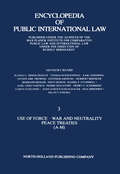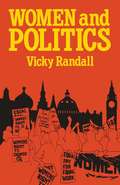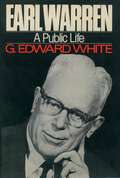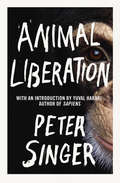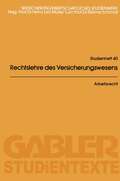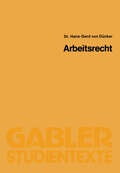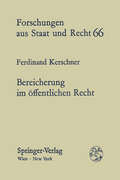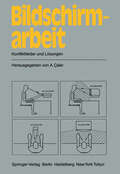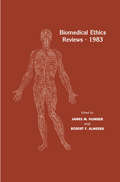- Table View
- List View
Therapists, Lawyers, and Divorcing Spouses
by William FisherExperts explore the need for cooperation between the law and helping professions in order to lessen the trauma of the divorce process.
Transportversicherung: Recht und Praxis in Deutschland und England (Die Versicherung)
by Enge Hans JoachimUse of Force · War and Neutrality Peace Treaties (A-M)
by Rudolf BernhardtEncyclopedia of Public International Law, 3: Use of Force, War, and Neutrality Peace Treaties (A-M) focuses on hostile inter-State relations and associated questions, including the use of force, war, neutrality, and peace treaties. The publication first elaborates on the Munich Agreement, mines, militias, military reconnaissance, objectives, necessity, government, and forces abroad, mercenaries, liberation movements, land warfare, intervention, international military force, indiscriminate attack, and the Kellogg-Briand Pact (1928). The text then ponders on humanitarian law and armed conflict, flags and uniform in wars, enemies and enemy subjects, disarming of belligerents by neutrals, demarcation line, deserters, economic warfare, combatants, contributions, and contraband. The book examines collective punishment, measures, security, and self-defense, boundary settlements between Germany and her western neighbor states after World War II, bombardment, armistice, arms control, Asama Maru incident, air warfare, and alliance. The text is a vital source of data for researchers interested in the use of force, war, and neutrality peace treaties.
Welfare Law and Order: A Critical Introduction to Law for Social Workers (Critical Texts In Social Work And The Welfare State Ser.)
by Pete Alcock Phil HarrisWho Decides?: Conflicts of Rights in Health Care (Contemporary Issues in Biomedicine, Ethics, and Society)
by Nora K. BellMany of the demands being voiced for a "humanizing" of health care center on the public's concern that they have some say In determining what happens to the individual in health care institutions. The essays in this volume address fundamental questions of conflicts of rights and autonomy as they affect four selected, controversial areas in health care ethics: the Limits of Professional Autonomy, Refusing! Withdrawing from Treatment, Electing "Heroic" Measures, and Advancing Reproductive Technology. Each of the topics is addressed in such a way that it includes an examination of the locus of responsibility for ethical decision making. The topics are not intended to exhaustively review those areas of health care provision where conflicts of rights might be said to be an issue. Rather they constitute an examination of the difficulties so often encountered in these specific contexts that we hope will illuminate similar conflicts in other problem areas by raising the level of the reader's moral awareness. Many books in bioethics appeal only to a limited audience in spite of the fact that their subject matter is of deep personal concern to everyone. In part, this is true because they are frequently written from the perspective of a single discipline or a single profession. As a result, one is often left with the impression that such a book views the philosophical, historical, and! or theological problems as essentially indifferent to clinical, legal, and! or policy-making problems.
Earl Warren: A Public Life
by G. Edward WhiteThis is a major biography of one of America's most influential and respected Supreme Court justices by a leading law scholar. In the late 1970s, Earl Warren's papers were opened and G. Edward White, a former law clerk of Warren, was given complete access to research this book. The result is the first study of the Chief Justice to cover his entire political career and to examine aspects of Warren's character that have seemed paradoxical. White goes back to Warren's roots in California Progressivism to illuminate his mid-century liberalism and the controversial decisions over which he presided in the Supreme Court. Based on a wealth of newly available information and White's understanding of Warren's work and personality, this is a fascinating, original portrait of Chief Justice Earl Warren.
Constitutional Fate: Theory of the Constitution
by Philip BobbittHere, Philip Bobbitt studies the basis for the legitimacy of judicial review by examining six types of constitutional argument--historical, textual, structural, prudential doctrinal, and ethical--through the unusual method of contrasting sketches of prominent legal figures responding to the constitutional crises of their day.
Allgemeiner Teil des Bürgerlichen Rechts: Zweiter Teil Die juristische Person (Enzyklopädie der Rechts- und Staatswissenschaft)
by Werner FlumeAnimal Liberation: Towards An End To Man's Inhumanity To Animals
by Peter SingerHow should we treat non-human animals? In this immensely powerful and influential book (now with a new introduction by Sapiens author Yuval Noah Harari), the renowned moral philosopher Peter Singer addresses this simple question with trenchant, dispassionate reasoning. Accompanied by the disturbing evidence of factory farms and laboratories, his answers triggered the birth of the animal rights movement.'An extraordinary book which has had extraordinary effects... Widely known as the bible of the animal liberation movement' Independent on SundayIn the decades since this landmark classic first appeared, some public attitudes to animals may have changed but our continued abuse of animals in factory farms and as tools for research shows that the underlying ideas Singer exposes as ethically indefensible are still dominating the way we treat animals. As Yuval Harari’s brilliantly argued introduction makes clear, this book is as relevant now as the day it was written.
Arztrecht und Arzneimittelrecht: Eine zusammenfassende Darstellung mit Fallbeispielen und Texten (Recht und Medizin)
by Erwin DeutschBereicherung im öffentlichen Recht (Forschungen aus Staat und Recht #66)
by Ferdinand KerschnerDie offentliche Hand nimmt (Abgaben; Gebuhren) und gibt bzw verteilt (Sozialleistungen), und das in immer starkerem AusmaB. Pro portional zur Haufigkeit derartiger vermogensrechtlicher Leistungen steigen auch Gefahr bzw Wahrscheinlichkeit von Fehlleistungen. Dem Pensionisten wird irrtumlich zuviel Pension uberwiesen, dem Enteig neten eine zu hohe Entschadigung ausbezahlt, der Unternehmer fuhrt - Freilich eher selten - zuviel Umsatzsteuer ab, ein Arzt zahlt aus Ver sehen seiner Sekretarin zweimal die Kammerumlage. Neben Dber zahlungen erfolgen auch reine Fehlleistungen. Nicht der berechtigte A, sondern der namensgleiche B erhalt Leistungen der Sozialfursorge. Der Grund fur derartige ungerechtfertigte Leistungen ist in der Regel in der Natur des Menschen, der fur sich oder die offentliche Hand ta tig ist, begrundet: Er irrt bisweilen. Schon das naturliche Rechtsgefuhl verlangt, daB solche rechtsgrund los en Vermogensverschiebungen auszugleichen sind. Die Rechtsgrund lagen fur dies en Ausgleich sind alles andere als klar. Zum Teil fehlen ausdriickliche Ruckabwicklungsnormen, existieren solche, haben sie meist bloB rudimentaren Inhalt, lassen somit Lucken und sind interpre tationsbedurftig. Dem Rechtsanwender stellt sich daher vielfach eine Reihe von Fragen: Kann uberhaupt die erbrachte Leistung zuruckver langt werden, wenn ja, in welcher Form, in welcher Hohe? Welches Entscheidungsorgan ist zustandig? Die ordentlichen Gerichte, die Ver waltungsbehorden oder gar der Verfassungsgerichtshof? Den Versuch einer Losung dieser Fragen hat sich die vorliegende Arbeit zur Auf gabe gemacht.
Bildschirmarbeit: Konfliktfelder und Lösungen (Informationstechnik und Datenverarbeitung)
by A. E. CakirInhalts}bersicht: Technisierung der Informationsverarbeitung - Gefahr oder Chance? - Technik und Umwelt. - Erfahrungen der Anwender. - Erfahrungen der Sozialpartner. - Normen und Regelungen. - Belastung und Beanspruchung. - Autorenverzeichnis. - Namen- und Sachverzeichnis.
Biomedical Ethics Reviews · 1983 (Biomedical Ethics Reviews)
by James M. Humber Robert F. AlmederIn the past decade the body of literature in the area of biomedical ethics has expanded at an astounding rate. Indeed, on every major topic, the literature in this area has mUltiplied, and continues to do so, so rapidly that one can easily fall behind important advances in our thinking about and understanding of the problems of contemporary bioethics. Awareness of this need to keep apace of developments in the area prompted a recent reviewer of our earlier collection Biomedical Ethics and the Law (Plenum, 2nd edition, 1979) to suggest that somebody ought to offer the service of providing a biennial review or update of the literature on the various central topics in bioethics. Thomas Lanigan, of The Humana Press, agreed with this last sug gestion and so asked us to edit a series of texts consisting of previously unpublished essays on selected topics, a series that would seek to re view and update recent literature on the central topics, while also striv ing to advance distinctive solutions to the problems on the topics under discussion. Accordingly, this first collection of previously unpublished essays focuses on the selected topics, and the authors commissioned were charged with addressing the basic problems assigned while also bringing the reader either directly or indirectly up to date on the rele vant literature.
The Citizenship Law of the USSR (Law in Eastern Europe #25)
by George GinsburgsIn 1968, the predecessor of this volume was published as Number 15 of the Law in Eastern Europe series, under the title "Soviet Citizenship Law". The decision to put out a new version of that study was prompted by the enactment in 1978 of the CUTTent Law on the Citizenship of the USSR and the various changes in Soviet prac tice in this domain which occurred in the intervening decade. I have drawn on the earlier work for background material and in order to make comparisons between the previous record here and the substance ofthe latest statute. However, the pres ent monograph is not a second edition in the sense of being an expanded and updated revision of the original, but stands as an independent piece of research and analysis. Thus, three of the chapters (out of a total of six) featured in the 1968 vol urne - citizenship and state succession, state succession and option of nationality, and refugees and displaced persons - have now been omitted for the simple reason that the situation in these areas has remained virtually static during the past ten years so that the initial treatment requires no significant alteration. On the other hand, fresh problems have meantime arisen - such as, for instance, the connection between citizenship and emigration, and the relationship between citizenship status and the international protection of human rights - which called for attention and are dealt with in this book.
The Clinical Encounter: The Moral Fabric of the Patient-Physician Relationship (Philosophy and Medicine #14)
by Earl E. ShelpThe encounter between patient and physician may be characterized as the focus of medicine. As such, the patient-physician relationship, or more accurately the conduct of patients and physicians, has been the subject of considerable comment, inquiry, and debate throughout the centuries. The issues and concerns discussed, apart from those more specifically related to medical theory and therapy, range from matters of etiquette to profound questions of philosophical and moral interest. This discourse is impressive with respect both to its duration and content. Contemporary scholars and laypeople have made their contribution to these long-standing discussions. In addition, they have actively addressed those distinctively modern issues that have arisen as a result of increased medical knowledge, improved technology, and changing cultural and moral expectation. The concept of the patient-physician rela tionship that supposedly provides a framework for the conduct of patients and physicians seemingly has taken on a life of its own, inviolable, and subject to norms particular to it. The essays in this volume elucidate the nature of the patient-physician relationship, its character, and moral norms appropriate to it. The purpose of the collection is to enhance our understanding of that context, which many consider to be the focus of the entire medical enterprise. The con tributors have not engaged in apologetics, polemics, homiletics, or em piricism.
The Constitution of the People's Republic of China: Adopted on December 4, 1982 by the Fifth National People's Congress of the People's Republic of China at Its Fifth Session
by China Publications China Publications CentreThe present Constitution of the People's Republic of China was adopted in December 1982 by the Fifth National People's Congress. The 138 Articles published in this book have developed over the years since the founding of the Republic, and define the fundamental laws of the state.
Contemporary Views on the Holocaust (Holocaust Studies Series)
by Randolph L. BrahamThis book is the second in a series of studies published under the auspices of the Institute for Holocaust Studies of the Graduate School and U niver sity Center of The City University of New York. Like the first book, it is an outgrowth of the lectures and special studies sponsored by the institute during the 1981-82 and 1982-83 academic years. This volume is divided into five parts. Part I, Ethics and the Holocaust, contains a pioneering investigation of one of the most neglected areas in Holocaust studies. Francine Klagsbrun, a well-known writer and popular lecturer, provides an erudite overview of the value of life in Jewish thought and tradition. With full understanding of the talmudic scholars' position on Jewish ethics and using concrete examples of the life-and death dilemmas that confronted many Jews in their concentration camp experiences, Klagsbrun provides dramatic evidence of the triumph of moral and ethical principles over the forces of evil during the Holocaust, this darkest period in Jewish history. The next two chapters, grouped under the heading The Allies and the Holocaust, deal with the failure of the Western Allies to respond to the desperate needs of the persecuted Jews of Europe during the Second World War. The first is by Professor Bela Vago, an authority on the Holocaust and East Central European history at the University of Haifa.
Das Konkursrecht: Einführung für Juristen und Kreditpraktiker
by Menno AdenDie vorliegende Darstellung des Konkursrechts und der Grundzüge des Vergleichs rechts entstanden aus der praktischen Arbeit des Verfassers in der Rechtsabteilung ei ner Bank. Das Buch wendet sich daher an den mit Konkursfragen befaßten Praktiker beiderseits des Bankschalters. Das Buch spricht aber auch den Juristen an, solange er keine Spezialfragen gelöst sehen möchte. Das Buch ist leicht lesbar, es enthält keine Fremdwörter oder Fachausdrücke, die nicht erklärt sind. Der Text ist mit Beispielen und Stellen aufgelockert, die dem Leser Atempausen lassen. Diese sollten aber nicht den Eindruck falscher Einfachheit ma chen. Andererseits sei hier, wie im Text verschiedentlich, betont: Die Regelung der Konkursordnung ist im Grunde ganz einfach, denn sie ist logisch. Die gesetzliche Rege lung wird nicht nur als gegeben hingenommen, sondern ihre innere Folgerichtigkeit wird durchgängig aufgezeigt. Dargestellt wird das Recht, wie es praktisch gilt, d.h. die herrschende Meinung der Rechtsprechung. Zum Gebrauch des Buches: die zitierten gesetzlichen Vorschriften sollte der Leser unbedingt lesen, und zwar jedesmal wieder, wenn sie zitiert werden. Der Referendar, Rechtspflegeanwärter usw. sollte Einzelfragen anhand eines Kommentars erst dann vertiefen, wenn er ein Kapitel durchgelesen hat und sicher ist, daß er den Grundsatz verstanden hat. Die in diesem Buch verwendeten Abkürzungen entsprechen den allgemein ge bräuchlichen. Statt vieler sei verwiesen auf das Abkürzungsverzeichnis in Palandts Kommentar zum BGB 1983. Der häufig zitierte Kommentar zur Konkursordnung von Mentzel, Kuhn und Uhlenbruck (9. Auflage, München 1979) wird verkürzt zitiert als M/K/U.
Das Kreditgeschäft im Lichte der AGB (Gabler-Studientexte)
by Jürgen W. WerhahnDie Fassung der entsprechenden Nummer 16 AGB(S) lautet wie folgt: "Der Kunde ist verpflichtet, die Sparkasse in jedem Einzelfall und gesondert darauf hin zuweisen, wenn aus Verzögerungen oder Fehlleitungen bei der Ausführung von Aufträgen oder von Mitteilungen hierüber ein über den Zinsausfall hinausgehender Schaden entste hen kann. Ist ein derartiger Hinweis erfolgt, so haftet die Sparkasse im Rahmen ihres Ver schuldens. Fehlt ein derartiger Hinweis, so haftet die Sparkasse nur für grobes Verschul den und, wenn der Auftrag zum Betrieb eines Handelsgewerbes gehört, beschränkt auf den Zinsausfall. " Erläu terungen 1. Die den Erfordernissen des Massenverkehrs Rechnung tragende Bestimmung der Nummer 7 AGB bezweckt den Ausschluß der Haftung für einen Verzugsschaden, der über den Betrag der einzuziehenden Forderungen und den durch Verzögerungen oder Fehlleitungen von Aufträgen entstandenen Zinsausfall hinausgeht. Ohne die hierdurch herbeigeführte Haftungsbeschränkung würde die Bank bei schuldhafter Verzögerung oder Fehlleitung eines Auftrags auch für weitergehende Schäden - beispielsweise also für einen dem Auftraggeber entgangenen Gewinn - haften. Nummer 7 enthält nach der höchst richterlichen Rechtsprechung indessen keine Freizeichnung von der Haftung für den Ver lust (oder die wesentliche Beeinträchtigung) einer einzuziehenden Forderung, der darauf beruht, daß der Auftrag infolge der Fehlleitung eines Schecks unausführbar geworden war. 2.


